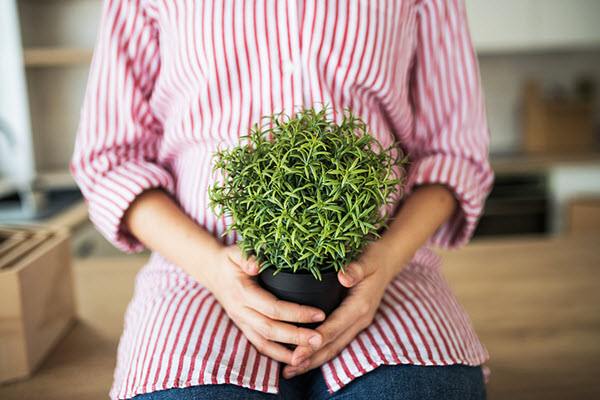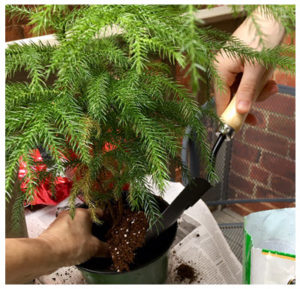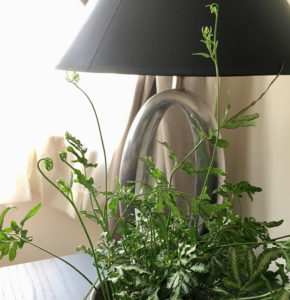It may not seem like much to anyone else, but my little plant, a small Norfolk Island Pine that I have nurtured from a truly tiny thing for the past two and a half years, is fighting. It is fighting to thrive in its current environment. Some days, I wonder how much longer it will survive.

This is a metaphor. A tough metaphor to face each morning.
It started out as one of those inexpensive plants you pick up at holiday time in the supermarket. It came wrapped in shiny red foil. Its little needles fanned out into a delicate canopy that couldn’t have been more than six inches across, seeming to float horizontally from its scrawny woody stems. Frankly, I was enchanted.
I set the little guy by the kitchen window. I sprinkled it with a bit of water each morning as my coffee was brewing. I watered it once a week. I did nothing else.
And it flourished.
That was in another location, not long after my first move now some two and a half years ago. It was a location where I most certainly wasn’t thriving. And yet the tiny Norfolk Island Pine was, slowly – very slowly – and I took comfort in that. I watched and sprinkled and watched and sprinkled and was delighted. Even in struggle, if we pay attention, we can find growth.
My challenges were many in that place, physically and emotionally. I was terribly isolated (in the middle of nowhere!), three sets of stairs kept me in constant (back) pain, and that, along with the frozen shoulder left me virtually housebound for nearly two years. Not fun! When I was finally able to move thanks to a fantastic physical therapist, I tackled the task of relocation with renewed hope.
In this (second) more recent relocation, since I was setting up shop in an old apartment with huge bay windows in its front room, a favorite spot to sit and write (as I am doing now), one of my sons suggested that I invest in more plants. I had only one, a pothos, that had traveled with me from Atlanta. And I had the tiny Norfolk Island Pine, still in its small pot and red foil wrapper, that seemed to symbolize, somehow, knocking back adversity.
So I took my son’s advice.
A trip to a local nursery led to some lovely house plants to cozy-up the ambiance of the apartment, to freshen the air as we know some plants do, to make good use of the front room light, and simply to enjoy. There is enormous pleasure in growing things.
I suspect that I have missed helping my children grow. While caring for plants is hardly the same, there is satisfaction in tending to them and seeing them happily do their thing.
For the first few months, my little pine seemed content here and grew rapidly. I was delighted! In fact, it grew so much that on one of my son’s visits, our mother-son activity was transplanting it into a larger pot. I deemed this necessary for another reason – a few of its fronds were beginning to brown.
Following our transplanting day, for a while, the pine was happy again! And then, not only did a few stems begin to brown, but they quickly dried and dropped off.
*
A dozen years ago I crossed the Atlantic to see a French physician to help me with one shoulder and arm that had stopped functioning, almost entirely. This was early on in my shoulder saga, a year or so after the initial injury, after American doctors had differed in identifying the cause of the problem and proposed various interventions that struck me as costly, risky, intrusive, and absurd.
The French physician examined me, looked at the scans I had brought, and offered a definitive diagnosis of a known complication. His solution: Do one very gentle exercise, daily, and allow the body to heal itself. He assured me that in this case, nature would do her job — though it might require nine months to a year for a good recovery.
I followed his instructions. My shoulder and arm returned to roughly 90% of their former range and capacity. It took 12 months.
*
 I poked around online to see what could be wrong with my little plant, and I tried everything I could think of – more light throughout the day (moving the little guy from window to window, following the sun), giving it a bit of plant food (not necessary previously), altering my watering habits (more thorough watering less often, sure to see the water drain out the bottom of the pot), and enlisting my son on another visit to re-pot a second time.
I poked around online to see what could be wrong with my little plant, and I tried everything I could think of – more light throughout the day (moving the little guy from window to window, following the sun), giving it a bit of plant food (not necessary previously), altering my watering habits (more thorough watering less often, sure to see the water drain out the bottom of the pot), and enlisting my son on another visit to re-pot a second time.
In the past month, although I have observed tiny, tender new shoots at the top, the browning and shedding of slender stems elsewhere has continued, rapidly. It is concerning. It makes my heart ache.
My little pine is struggling to adjust to something beyond my reach, something I cannot put my finger on, something unsuitable in this environment that held – and still holds – so much hope. I am increasingly aware of the tiny plant’s fragility and likewise, its insistence on reaching toward the light.
*
I have been in physical therapy for three weeks now. The latest physical therapist at the latest facility. I like the therapist, he is reasonable and rational, we are trying varying approaches, and I will continue to give it a chance. But so far it isn’t helping. I am discouraged. I am running out of ideas.
*
There is another little plant that I have taken to, some sort of fern with a name I cannot recall. It is the only plant from the nursery that survived beyond three months, much to my dismay, despite following directions relative to light, humidity, watering and so on.
 The fern is always thirsty, needs daily tending, and for a while, it too seemed to struggle. I was concerned that it was going to die. And then tiny tendrils began appearing, tightly wound curls in bright green, mysterious and fascinating.
The fern is always thirsty, needs daily tending, and for a while, it too seemed to struggle. I was concerned that it was going to die. And then tiny tendrils began appearing, tightly wound curls in bright green, mysterious and fascinating.
One morning, when I came out to sit by the window with my coffee, I saw that they were unfurling into shoots, and two days later there was an entire set of brand new leaves. It is a small thing, a small win I had nothing to do with, a small delight that felt, somehow, so big, so wondrous.
Regeneration is a remarkable thing.
But another stem dropped off my Norfolk Island Pine this morning. It was still bright green, seemingly healthy, in its prime. I am more worried about the little plant than usual.
If worrying about a house plant seems ridiculous, I agree. It isn’t just that I am a worrier, though I suppose that I am. It is this. I enjoy caring and to a degree, I need to nurture – nurturing people, animals, and apparently plants. To see struggle – in a person, a relationship, or even a plant in which you have invested time and caring – or worse, to witness it withering and to feel helpless to stop it, well, of course, it is difficult.
When you begin to see your own life in something as simple as a little plant, working hard to adapt, seeming to do better and then struggling again – it is a strange, stark mirror, even if no one else would find it to be a mirror at all. And of course, it is a universal story of two steps forward and one step back; a human story that we all, at times, experience.
About 10 days ago I ventured to a nearby Lowe’s and picked up an inexpensive plant to place on a table on a small, worn landing by my back door. Coleus, I think. When I go in and out, for however long the plant survives, I will take pleasure in the deep purple-red color of its leaves, in the way it shudders so prettily in the spring and summer air, and I will do my best to care for it. That’s all we can ever do, really. Our best at any point in time.
A few minutes ago, I turned to the nameless fern with its crazy, tangled, delicate, demanding shoots and curls and leaves, with its bad days and its nothing days and its sudden, surprising new growth, and in it, I find another opportunity for metaphor. Perhaps, this is a lesson in the value of patience. Perhaps, this is a lesson in allowing nature to do her thing.
You May Also Enjoy

I was going to guess drainage. Or else it didn’t like the potting soil you used. But I’m no expert.
My green-thumbed grandmother had a tiny shotgun house with a huge sunporch on the back, full of plants. She had a pretty wicker basket, now chez moi, with African violets (and I did see fuzzy-leafed violets in Africa). She advised me that plants needed to be talked to. Then she demonstrated. She bent over the violets and, in a no-nonsense voice, declared “if you don’t bloom, you’re going out!”
Seriously, though, I believe that plants are sentient, just not on a level we can comprehend. There are some studies to support this, and a cool TED Talk.
As for PT, I am not surprised that the French doctor told you it would take time. Here, you get time to heal. Not everything can be fixed immediately with a couple of pills.
Hmmm. In my previous location, I didn’t talk to my little plant. And it thrived. In this location, I actually do talk to it – politely and sweetly, I might add. Maybe I should just shut up?
Potting soil. I hadn’t thought of that.
As for American medicine – to fix a shoulder and arm problem, the American “brain trust“ wanted a “procedure” in my neck that might result in temporary paralysis – wtf?!? Uh-huh.
When I said no to that, they would no longer see me.
Turned out their diagnosis was incorrect. Good thing I went with my gut on that one. And I wasn’t about to risk paralysis (temporary or otherwise) as the sole responsible adult for, at the time, two little boys.
Yeah. Let’s hear it for real medical care…